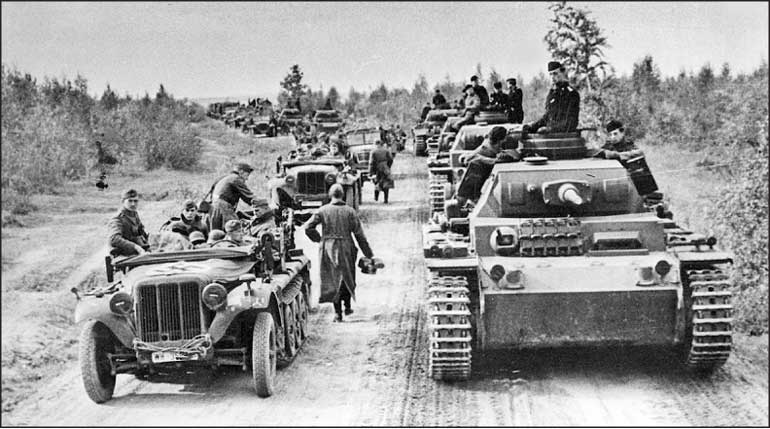Monday Apr 21, 2025
Monday Apr 21, 2025
Saturday, 25 June 2022 00:10 - - {{hitsCtrl.values.hits}}

The titanic clash that began in that summer of 1941 demanded of the combatants, super human effort, amazing physical endurance, boundless courage, iron discipline, selfless comradeship and finally, the unflinching sacrificing of oneself
“We have only one task, to stand and pitilessly lead this race battle. The reputation for horror and terror which precede us we want never to allow to diminish. The world may call us what it will…” – Heinrich Himmler – 1943

When Adolf Hitler founded his Third Reich in January of 1933 there was a decisive ‘quickening’ of history towards the cataclysmic Second World War. In the form of Nationalist Socialism of the Nazi Party, a strong capable race had embraced an assertive philosophy, as events would show a portentous development for the rest of the world.
Despite their mighty efforts in the First World War, the defeat in 1918 left the Germans humbled, confused and embittered, their once strong and orderly country reduced to near anarchy. After the tumultuous years that followed, in 1933, the National Socialist Party of Adolf Hitler seemed to many the benediction the nation had long prayed for.
By 1939, in six short years, the evident abilities of the disciplined German race had once again created a powerful nation possessed of an awesome military machine. A martial race was armed and ready. Led by its extraordinarily able General Staff, which both friend and foe considered a “corps d’elite”, Hitler’s Wehrmacht was easily the best fighting machine in the world at the time. It was said of the German officer class that they were “men of out- standing intellectual aptitude and physical stamina, governed by a code of ascetic self-discipline. Their strength lay in their complete self-effacement to the point of anonymity. In times of peace they were expected to devote themselves wholly to knowledge and education. In war, outstanding bravery, capability and sacrifice were demanded of them.”
As the war drums rolled across Europe in 1939-40, the aggressive German army triumphed with surprising ease over once vaunted armies of Poland, France and other European nations. In the case of the French, they in fact outnumbered the Germans in many strategic aspects such as in men and tanks. But in military thinking they seemed stuck in earlier wars, of trench warfare or even the Napoleonic times, when the infantry or the cavalry charge won the day.
The Germans on the other hand, were ready for mobile warfare fought with mechanised armoured forces, closely supported by deadly accurate air and artillery power while making optimum use of advance technology such as the radio for real time communication. The French were conquered in a few short weeks. The British were never more thankful for the English Channel! After a half-hearted attempt to subdue the stubborn island with air power alone, Hitler turned his eyes to the East. The stage was now set for the greatest human conflict in history.
The Soviet Union, the largest country in the world, and which perhaps maintained the biggest army at the time, was shrouded in mystery. The Stalinist system did not provide statistics of its military strength at information bureaus. But it was obvious that in comparison to Western Europe, the conditions in the Soviet Union were poor, even primitive. The Russian roads were not anything like what the motorised German army had used in Europe. There were very few all-weather roads in the country, proving a terrible obstacle in bad Russian weather conditions. And unlike other countries the Germans had vanquished in the previous summers, the Soviet Union was much too large to be brought under in one aggressive dash.
But the German army, full of confidence after its remarkable achievements in the previous summer campaigns, had come to believe that nothing was impossible for the German soldier. Addressing the higher echelons of the army Hitler boastfully predicted that when ‘Operation Barbarossa’, the name given to the German plan for the impending campaign against the Soviet Union, “the world will hold its breath”. “One good kick on the door and the entire rotten structure will collapse” he further emphasised his conviction that the Soviet Union was no match for the proven, battle hardened German war machine.
This confidence, eventually to prove the undoing of that fine fighting machine, was reflected in the astonishing fact that the German army launched the war against the Soviet Union where it was expected to conquer an area of about one million square miles in one summer campaign with just a few more divisions more than it had deployed in the previous summer against France, a country of approximately 150,000 square miles.
For the “good kick on the door” the Germans gathered nearly four million soldiers on their long Russian border. Provided air cover by the vigorous Luftwaffe, supported by nearly 4,000 pieces of heavy artillery, and most importantly, given the cutting impetus by the brilliantly led panzer divisions, the German army’s campaign in the East was indeed going to open with a breath-taking fury.
In view of the immense land area it had to conquer with human resources Germany could ill-afford to keep in uniform for too long, the Wehrmacht had to gain a decisive result in that summer of 1941. With this strategic goal in mind, its military planners aimed at fatally wounding the Red army west of the Dnieper River. Committing themselves to a huge undertaking with limited resources and a clear numerical weakness (in terms of population and hence capacity to mobilise in the long term), the Germans were gambling on the skills and capabilities of its soldiers to bring them a quick victory.
For operational purposes they divided their forces into three large army groups. The Army Group North under the command of Field Marshal von Leeb was to capture the Baltic area and Leningrad (St. Petersburg). The Army Group Center under Field Marshal von Bock was to drive to Moscow through the Russian heartland. Field Marshal von Rundstedt leading the Army Group South was to bring the fertile Ukraine under its heel.
After a few nervous postponements, the date for the opening of the campaign was fixed for 22 June, the same day that Napoleon, in 1812, launched his ill-fated invasion of Russia. Starting their eastward thrust at about 3 a.m. on that day the German war machine once again gave an almost flawless display of its awesome prowess. Within 48 hours more than 2,000 Russian fighter planes were down. The German Panzer divisions exploiting the gaps their opening salvos punched in the defensive barriers of the Russians, drove on eastward relentlessly with the aim of achieving strategic dominance, leaving the task of destroying the shocked and confused stragglers of the enemy forces to the rapidly following infantry divisions.
By mid-July, in just three weeks of intense fighting, Russians had lost 3,500 tanks, 6,000 planes and more than two million men. The famous German tank commander General Heinz Guderian leading a powerful armoured corp attached to the Army Group Center noted in a memorandum that the “Russians were severely hampered by political demands of the State leadership and suffered a basic fear of taking responsibility. This, combined with bad coordination meant that orders to carry out necessary measures, counter-measures in particular, are issued too late. Soviet tank forces were insufficiently trained and lacked intelligence and initiative during the offensive.”
In these early stages of the war to many observers it appeared that the Wehrmacht had once again delivered a death blow to a powerful adversary well before it could even fully comprehend the attackers’ diabolical intentions.
Although German propaganda portrayed the average Russian as no match to the masterful Teutons, a semi-Asiatic primitive of sub-human qualities, it did not take long for the German soldiers to realise that in the Russian vastness they were facing a fight to the death with this Slav/Mongol race. On that bloody battlefield German skills confronted Russian stubbornness, the attacker’s courage was met by the defenders’ recklessness, the conquerors contempt was matched by the hatred of resisters.
The Eastern campaign that began so dazzlingly for the invader on 22 June 1941 raged on in the mind-boggling vastness of Russia until mid-1945. The young soldiers of the two nations were locked in a war of savagery on a scale rarely witnessed in human conflict. Russia alone suffered nearly 30 million deaths (more than 10 million soldiers) in those four years of relentless fighting.
Nazism and Communism, the ideologies professed by the two armies that clashed with such bitterness in 1941, are dead in these two countries today. Germany has rebuilt, becoming one of the most prosperous nations on the planet. Russia, after her failed experiment with Communism is yet struggling to find a place in world affairs that befits its size and potential. But they both surely remember the four years when the best of these two brave nations fought on a terrible battlefield and often died a soldier’s death.
War is a terrible, tragic, and most times a wasteful thing. But paradoxically, war often brings out some of the best qualities in man. The titanic clash that began in that summer of 1941 demanded of the combatants, super human effort, amazing physical endurance, boundless courage, iron discipline, selfless comradeship and finally, the unflinching sacrificing of oneself. The stage and the human actors of that bloody drama to this day inspire awe by its sheer scale, intensity, wickedness as well as its undeniable heroism.
“Two things have altered not, since first the world began, the beauty of the wild green earth, and the bravery of man.”
Discover Kapruka, the leading online shopping platform in Sri Lanka, where you can conveniently send Gifts and Flowers to your loved ones for any event including Valentine ’s Day. Explore a wide range of popular Shopping Categories on Kapruka, including Toys, Groceries, Electronics, Birthday Cakes, Fruits, Chocolates, Flower Bouquets, Clothing, Watches, Lingerie, Gift Sets and Jewellery. Also if you’re interested in selling with Kapruka, Partner Central by Kapruka is the best solution to start with. Moreover, through Kapruka Global Shop, you can also enjoy the convenience of purchasing products from renowned platforms like Amazon and eBay and have them delivered to Sri Lanka.
Discover Kapruka, the leading online shopping platform in Sri Lanka, where you can conveniently send Gifts and Flowers to your loved ones for any event including Valentine ’s Day. Explore a wide range of popular Shopping Categories on Kapruka, including Toys, Groceries, Electronics, Birthday Cakes, Fruits, Chocolates, Flower Bouquets, Clothing, Watches, Lingerie, Gift Sets and Jewellery. Also if you’re interested in selling with Kapruka, Partner Central by Kapruka is the best solution to start with. Moreover, through Kapruka Global Shop, you can also enjoy the convenience of purchasing products from renowned platforms like Amazon and eBay and have them delivered to Sri Lanka.